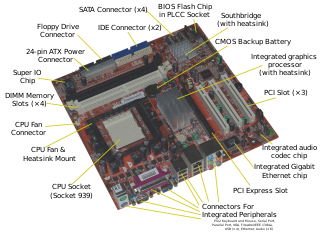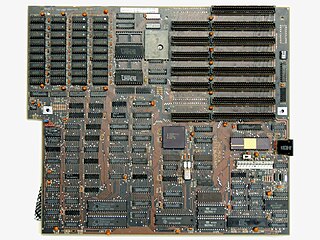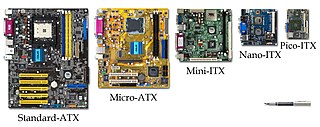This article does not cite any sources .(November 2015) (Learn how and when to remove this template message) |
SWTX (Server / Workstation Technology eXtended) is a proprietary computer case and motherboard form factor used by Supermicro primarily for 4-socket servers.
A computer is a machine that can be instructed to carry out sequences of arithmetic or logical operations automatically via computer programming. Modern computers have the ability to follow generalized sets of operations, called programs. These programs enable computers to perform an extremely wide range of tasks. A "complete" computer including the hardware, the operating system, and peripheral equipment required and used for "full" operation can be referred to as a computer system. This term may as well be used for a group of computers that are connected and work together, in particular a computer network or computer cluster.

A motherboard is the main printed circuit board (PCB) found in general purpose computers and other expandable systems. It holds and allows communication between many of the crucial electronic components of a system, such as the central processing unit (CPU) and memory, and provides connectors for other peripherals. Unlike a backplane, a motherboard usually contains significant sub-systems such as the central processor, the chipset's input/output and memory controllers, interface connectors, and other components integrated for general purpose use and applications.
In computing, the form factor is the specification of a motherboard – the dimensions, power supply type, location of mounting holes, number of ports on the back panel, etc. Specifically, in the IBM PC compatible industry, standard form factors ensure that parts are interchangeable across competing vendors and generations of technology, while in enterprise computing, form factors ensure that server modules fit into existing rackmount systems. Traditionally, the most significant specification is for that of the motherboard, which generally dictates the overall size of the case. Small form factors have been developed and implemented.
Longer but narrower than WTX, SWTX motherboards are not compatible with (E)ATX cases because of their size and mounting scheme. Likewise, ATX motherboards are not compatible with SWTX cases.

WTX was a motherboard form factor specification introduced by Intel at the IDF in September 1998, for its use at high-end, multiprocessor, multiple-hard-disk servers and workstations. The specification had support from major OEMs and motherboard manufacturers and was updated (1.1) in February 1999. As of 2008 the specification has been discontinued and the URL www.wtx.org no longer hosts a website and has not been owned by Intel since at least 2004.

ATX is a motherboard and power supply configuration specification developed by Intel in 1995 to improve on previous de facto standards like the AT design. It was the first major change in desktop computer enclosure, motherboard and power supply design in many years, improving standardization and interchangeability of parts. The specification defines the key mechanical dimensions, mounting point, I/O panel, power and connector interfaces between a computer case, a motherboard and a power supply.
Dimensions: from 16 × 13 in (406 × 330 mm) to 18 × 13 in (457 × 330 mm). Most SWTX boards seem to be in the middle of this range, around 16.48 × 13 in (419 × 330 mm).
| This computer hardware article is a stub. You can help Wikipedia by expanding it. |







